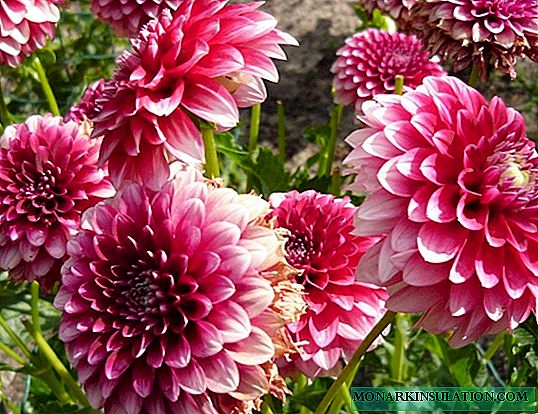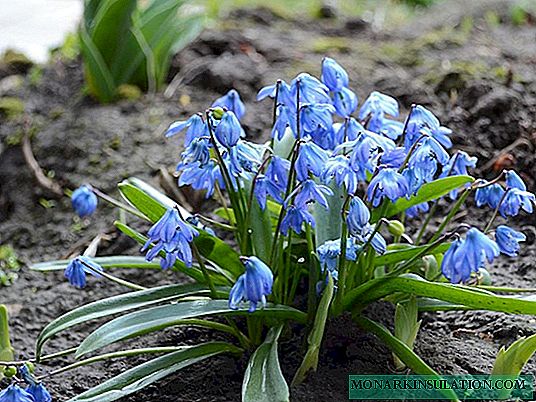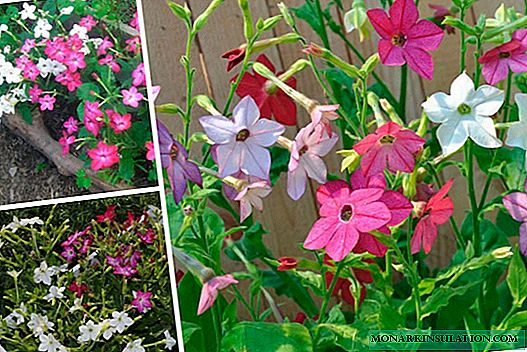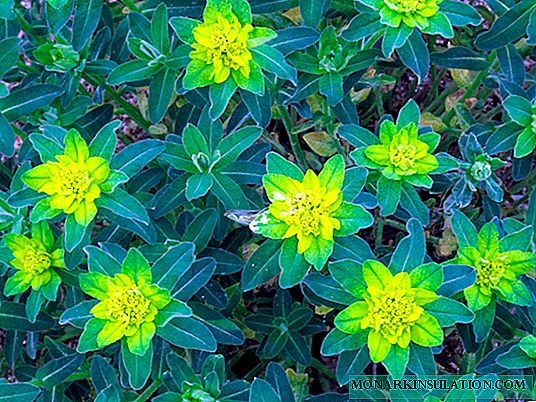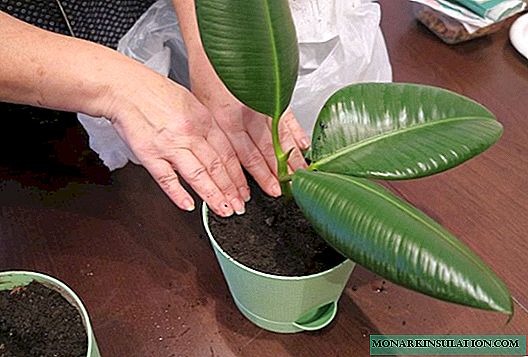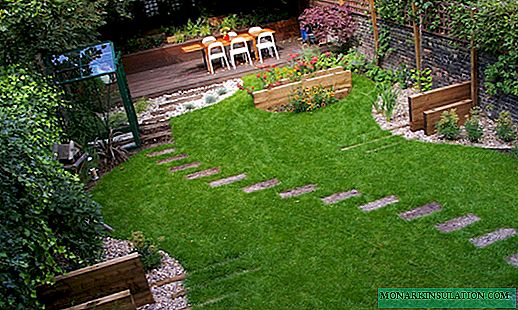
It often happens that our desires go beyond possibilities. And then it turns out that the idea of creating a house, a garden and several necessary outbuildings on a small plot faces objective difficulties: there is simply not enough space for everything that was planned. How, in this case, to design a modest space in order to realize that for which everything was started? After all, the site was acquired in order to break out of the city and be closer to nature. So let at least a mini garden, but it will be.
The art of designing a mini garden consists in the fact that the space increases, first of all, in the imagination of the person who is in it. You can’t make a small big, but make the viewer get the impression that there is a lot of space around him, you can and should. This effect is achieved by various methods.

If you take a closer look, it turns out that this idyll with a pond and a gazebo does not take up as much space as it seems
Let's not rest against the wall
First of all, it is necessary to work with what physically limits the area of the allotted space - with a fence. A dull and impenetrable fence creates a feeling of isolation, turning a cozy courtyard into a box, which is about to be closed with a lid. Therefore, it is better to use an openwork fence or a netting netting, decorating it with flowering climbing plants.

Until the plants grow, the fence will look too permeable, so some still prefer a solid fence
But sometimes, due to the proximity of neighboring buildings, the use of a "transparent" fence creates certain inconveniences. A possible way out in this case would be a fence with blinds. The space can be visually expanded only when the owner of the site has a need for it or until the climbing plants are covered with leaves.

The amazing optical effect of "dragonfly eyes" allows not only to visually expand the space, but also to gain a reputation as a conflict-free neighbor
Even the presence of a neighboring garage, the wall of which partially replaces the fence, will not be superfluous if you accept it as a full-fledged participant in your game with optical effects. Convex mirrors attached to this wall distort the reflection of the garden. The perspective that has formed in them is deeper than it really is. Such "dragonfly eyes", placed on a chocolate-colored wall, transform a small lawn into a rather spacious lawn.
The Secret to the Right Garden Path
Science fiction writers like to use the technique of curved space when a small outside object from the inside looks completely different. We will also try to bend the space with the help of curved garden paths. After all, if the track winds, then the journey along it will last longer. It seems to the walker that his path runs through a section of a much larger area.

Garden paths running somewhere into the distance attract the eye of the observer, expand the space of your mini kindergarten and look a little mysterious
If, where the space is clearly visible into the distance, to make transverse paths, and to allow longitudinal ones to loop between flowerpots and behind bushes, an illusion of a greater width of the plot will appear. If the path runs along a narrow strip of the garden, then you can paint the fence into which it rests, paint it in its colors and cover its upper part with hanging vines and flowers. It will seem that a looping stitch goes right up the fence somewhere into the sky.

A neat path escapes beyond our sight, and a graceful arch, entwined with abundant greenery, turned out to be very useful here
Particularly fabulous are the tracks leading "to nowhere." If the path leads away to the dense greenery growing not far from the fence, then the observer’s deluded vision will give him the impression that, in the place where the path ran, the garden itself continues.
Mirror water surface
In order for the walker not to be able to fix his attention on the contemplation of the site as a single object, it is necessary to offer him new impressions. The magician acts on the same principle, making distracting passes with his hands. Spectacular small details and their charm distracts from the fact that the territory on which all this is located is extremely small.

The two most popular ponds for a mini garden are a small fountain near the wall and a pond on two levels with a bridge
A great distraction is a reflection. It has a bewitching effect. And what in a small garden can be used as a reflective surface? The water surface of a small neat pond! Such a reservoir does not take up much space. It can even be a stream flowing along the side of the site. Another option is a pond in two levels with a bridge thrown over it. Own reflection in water always attracts attention.
If the area is small, it is better not to use flowing water. The noise of falling water can be too intrusive. If, nevertheless, the idea to arrange a fountain or a waterfall captures you and does not let you go, choose a place for it somewhere near the fence, be sure to coordinate your decision with your neighbors. After all, the constant sound of flowing water should not annoy them either.

One of the three phenomena that a person is able to watch forever is considered to be flowing water. This nook is designed to enjoy this sight
The size of the tree does not matter
Even the smallest garden cannot do without trees. If you like big trees, the size of the plot should not dictate life rules to you. Do you want to plant a big tree? Let it be! Just imagine what a delightful coolness will give you on a hot summer day its magnificent spreading crown. You can place a tree in the middle of the plot, and plan a recreation area right below it.

Who said that, without exception, all plants in a small area should be dwarf? This misconception can be easily dispelled.
If you use a circular layout, surrounded by vegetation on all sides, even if it is just fenced with greenery, the impression of being in a large garden will be born. From the center of the garden there is a great viewing opportunity: you can perfectly plan the “folded” space around you.

Here is the second placement option, in which a large tree is also not superfluous. A relaxation area in the shade of his crown can become the most comfortable place in the whole garden
Vertical gardening techniques
Of course, you cannot plant a garden with a single, albeit a large tree. Turning it into a lush flowering corner will help not only the right choice of plants, but also a competently applied method of planting.
The vertical gardening method is especially important for a modest sized site. To make walls of greenery, arches, garden grates, fences, pergolas, facades and arbor barriers are used. Screens and trellises are the most common decorative elements in the arrangement of mini kindergartens. They are used both as independent elements, and in combination with flowerpots, flower beds and various garden accessories. They are also used to delimit individual areas of the site.

Using vertical gardening, it is very important to carefully select plants for this purpose, because hops, for example, are able to fill the entire area
Different varieties of wild grapes, decorative beans, hops, sweet peas, clematis are suitable as plants for vertical gardening. In order for all this wealth to be abundantly covered with greens and flowers, many factors must be taken into account during planting: soil condition, amount of precipitation, shadowiness, prevailing wind direction and other features specific to your site.
By the way, not only garden, but also garden plants can be used as greenery. Very interesting vertical gardens are created using plastic bottles. To avoid monotony in perception, it is more correct to use different plants.

A bench in colors is a popular design technique for expanding the space, which makes a lasting impression on the spectator who sits on such a bench
Place an ordinary bench near the fence and build a tall flowering arch twined with roses directly above it. If you now sit on this bench, there will be a complete feeling that a spacious garden stretches around you, in the depths of which you are. Techniques for creating a wild and slightly neglected garden are always effective precisely in areas with limited space.

The lush greenery and mats surrounding the garden space create the illusion that the real jungle surrounds your plot from all sides
Planting is best done in a cascading fashion when small plants in flower pots are brought to the fore. The size of the plants increases gradually. Tall flowers, bushes and small trees can be placed in flowerpots or even barrels. Cascading design makes it easy to create an effect when the observer’s gaze slides upward diagonally. A similar result can be achieved if vertical gardens are used.

Flowerpots with flowers allow not only creating amazing compositions, but also changing them as often as the author wants
Why did we mention flowerpots? Because the placement of plants in them allows you to change the design of the site, simply rearranging them for even one season, exactly as we currently want.
Another unusual idea that we rarely realize where: you can find a wonderful place for picturesque landscaping directly on the roof of garden buildings. This method allows you to simultaneously solve two problems. Firstly, a new platform for planting is being created, and secondly, excellent additional thermal insulation of the roof is provided. Even in the heat of the room, coolness will remain. Finally, it's just beautiful!

Such a farm building with grass on the roof looks just fabulous. Of course, it is not suitable for any style, but the idea is not bad
Garden design at different levels
It doesn’t matter if the plot is flat, like a table, for a small garden you can always equip a small podium or even a terrace. For a site on a slope, a terrace is the most successful design technique. If one and the same site is considered as a plane and in the form of zones located at different levels, then the illusion of a more spacious garden will be present only in the second case.

It seems that the garden, broken at different levels, really accommodates even more all sorts of elements, becoming more voluminous
By the way, you can create multilevel zones both in height and in depth. It is not necessary to hammer the ground for this. It is enough to apply a 3D illusion, using materials of different shades when paving the playground for the playing area. Such a technique will never go unnoticed.

And this is generally a pure optical illusion, which gives the viewer a full sense of deepening in the center of the playground
Another trick from the magician’s arsenal
Bright scarves in the hands of the illusionist are also part of the program. Therefore, do not forget about the proportional elements of the decor, such as garden sculpture, dry streams, lamps, bells, attractive garden furniture and other manifestations of creativity that everyone loves so much. Do not forget about children - the flowers of life, if you have them, of course.

Openwork garden furniture combined with lace flowers and grace of the arch, which is located nearby, creates a feeling of airiness, do not clutter up the space
Speaking of flowers. The nuance of choosing flowers for planting in small gardens is the rejection of the use of plants of one variety. Choose a variety of flowers, when looking at which you don’t want to look for signs of a fence between them. If the use of one variety dictates the unity of the chosen style, choose the rhythmic planting of plants with bright colors.

On this example, I would like to show how the house can not compete with the kindergarten, reducing its area, but organically merge into it, become part of it
If you don’t have enough space for a full-fledged lawn, and annoying bald spots appear on especially shaded areas, use moss. It remains green even in late autumn and during the fall leaf fall helps you deal with seasonal depression.
It remains only to look around the site with a critical eye. Is there still room for the manifestation of our creative imagination? If the owners of even a tiny site have a desire to make it a truly magical place, they can achieve this. Make sure of this by watching the video below.
Video # 1:
Video clip # 2:

